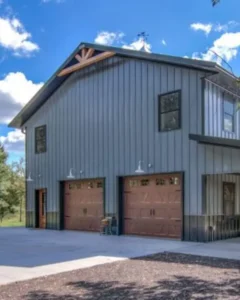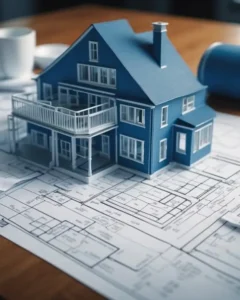If you are here only for the plans you can get there directly here!
Introduction to Shop House Plans
Shop houses, often referred to as “shouses,” are a unique blend of residential living and workspace that cater to the needs of homeowners looking for a functional solution to combine their work and personal life under one roof. These structures are characterized by their efficiency, durability, and customizable nature to fit various lifestyles and business requirements.
A shop house typically features a large open space suitable for a workshop or commercial use, seamlessly connected to a comfortable living area. The design often includes high ceilings and sturdy construction materials that reflect its dual-purpose nature. The flexibility in shop house floor plans allows individuals to tailor their space to their needs, whether it be for hobbyist activities, storage, or business operations.
Key elements of shop house plans:
- Combination of living space and workshop
- Customization to owner’s requirements
- Energy-efficient materials and design
- Durable construction with commercial-grade framing
Individuals who opt for a shop house enjoy the practicality of having a dedicated space for projects while not compromising on the comfort of home. These structures are particularly popular among those looking to reduce their commute, enhance work-life balance, and own a versatile building that can adapt to changing life stages or business needs.
The adaptability of shop houses can be seen in the diversity of their designs, from minimalistic one-bedroom layouts to expansive multi-bedroom configurations. For example, individuals interested in a 40×80 space can find inspiration from a variety of 40×80 shop house floor plans, which can provide valuable ideas during the planning stages.
Understanding Shop House Design

When diving into shop house plans, one must consider the blend of residential comfort with commercial functionality. These structures are designed to house both living quarters and a substantial workspace or storage area.
Architectural Styles
Shop houses, or shouses, feature a variety of architectural styles. Some echo traditional residential aesthetics, while others display a modern or industrial look. The choice often depends on the homeowner’s preferences and the intended use of the space. Companies like BuildMax cater to those looking for customized solutions that complement their lifestyle and business needs.
Zoning and Building Codes
It is crucial for shop house plans to adhere to local zoning and building codes. These rules impact design specifics, such as structural integrity, fire safety, and electrical systems. Prospective builders or buyers should consult their local building authorities or a design professional to ensure compliance. Morton Buildings often designs with these regulations in mind, creating structures that are both functional and lawful.
Efficient Use of Space
Efficient use of space is fundamental in a shouse, where one must merge living and work areas without compromising comfort or functionality. Open floor plans are common, offering flexibility for various activities. Features such as built-in storage and multipurpose areas are common, as noted in resources like Barndominium Life, which showcases how well-designed spaces can cater to a broad range of needs from storage of recreational vehicles and boats to dedicated hobby areas.
Design Elements of Shop Houses

When designing a shop house (shouse), one must consider the unique blend of residential and commercial space that defines this structure. Key elements include efficient floor plans, robust materials, and effective insulation and ventilation systems to ensure comfort and functionality.
Floor Plans and Layouts
Strategically designed floor plans are crucial in shouses, providing seamless integration of work and living spaces. They often feature open concept spaces, vaulted ceilings, and possibly lofts or balconies that oversee the work area. Shop house floor plans are flexible, catering to a variety of needs, and often include multipurpose areas that can be easily adapted. For example, the interiors are wide open spaces with vaulted ceilings, complemented by balconies that overlook great rooms and strike a balance between the workshop and personal zones.
Materials and Construction Methods
Shop houses are frequently constructed with commercial-grade metal framing and sheeting, ensuring durability. They can be built using steel frames, pole barn construction, or traditional stick-built methods. The choice of materials impacts not just the aesthetic of the shouse, but also its longevity, maintenance needs, and resistance to elements. Materials are selected for their energy efficiency and ability to be customized to specific requirements. These customized structures are known for their energy efficiency and enduring nature.
Insulation and Ventilation
Proper insulation is a pillar of shop house design, contributing to temperature control and energy efficiency. High-quality insulation materials help reduce heating and cooling costs and create a comfortable living and working environment. Ventilation, on the other hand, is essential to ensure a fresh air supply and to prevent condensation, which is especially important in areas combining living space with workshops that may generate more dust or fumes. Effective systems need to be in place to ensure quality air circulation throughout the shop house.
Building Your Shop House

When embarking on the construction of a shop house, or “shouse,” it’s essential to engage with skilled professionals, understand the construction stages, and procure the right tools and equipment.
Hiring Professionals
Choosing the Right Team: For a successful project, homeowners should select a qualified architect and a reliable contractor. The architect will be instrumental in creating custom Shouse floor plans tailored to their needs, while the contractor handles the actual build, ensuring it meets local codes and personal requirements.
Construction Stages
Foundation to Finishing: Building a shouse involves several critical stages:
- Site Preparation and Foundation: Laying a stable foundation is crucial. This stage includes clearing, excavation, and pouring concrete.
- Framing and Structure: The core structure, typically featuring commercial-grade metal, is erected, as detailed in various shop house kits.
- Exterior and Interior Work: Includes installing the roof, walls, insulation, and then moving indoors for drywall, plumbing, and electrical work.
- Customization and Detailing: Final finishes and personal touches transform the space into a cozy home paired with a functional workspace.
Equipment and Tools
Essential Gear: Building a shouse requires specific tools and equipment during each construction phase. For heavier tasks, construction equipment like backhoes and concrete mixers are used, while power tools, such as drills and saws, are necessary for the framing and finishing stages.
- Heavy Machinery: Include items like excavators and cranes.
- Power Tools: Drills, saws, and nail guns are common needs.
- Hand Tools: Hammers, screwdrivers, and levels aid in precision work.
It’s important that safety equipment such as hard hats, gloves, and goggles are used throughout to protect everyone on site.
Exterior Features
Shop house plans often blend practicality with aesthetic appeal. The following aspects are crucial to their curbside charm and functionality.
Landscaping and Outdoor Areas
Landscaping is tailored to complement the barn home charm, with selections that enhance the home’s modern lines. Outdoor spaces might include a wraparound porch, offering both visual appeal and a transition area between work and living spaces.
Parking and Accessibility
These structures provide spacious parking solutions, oftentimes including an attached two-car garage with direct entry to the main home. An adjacent shop may feature additional bays or overhead doors to cater to both residential and commercial vehicle needs.
Security Considerations
Shop houses integrate security features that safeguard both the residential and commercial sections. The design may incorporate well-lit exteriors and strategically placed surveillance cameras, with consideration for the privacy and security of each distinct area.
Shop House Plans Inspirations





If you prefer to get inspiration from a video, I recommend this one:
What does a shop house look like?
A shophouse typically features a narrow frontage with a sheltered corridor at the front for pedestrians, multiple stories, residential space above, and a shop on the ground floor with direct street access.
What is the purpose of a shophouse?
The purpose of a shophouse is to combine residential and commercial space, with the ground floor serving as a shop or business and the upper floors as a home.
What is shophouse architecture?
Shophouse architecture is a vernacular style found in urban Southeast Asia, characterized by mixed-use buildings with commercial space on the ground floor and residential quarters above.
If you liked this blog article about the topic “Shop House Plans”, don’t forget to leave us a comment down below to tell us about your experience.
Not enough inspiration yet?
Feel free to also check out our other Articles from the category “Tiny House“ and don’t forget to follow us on Pinterest.





